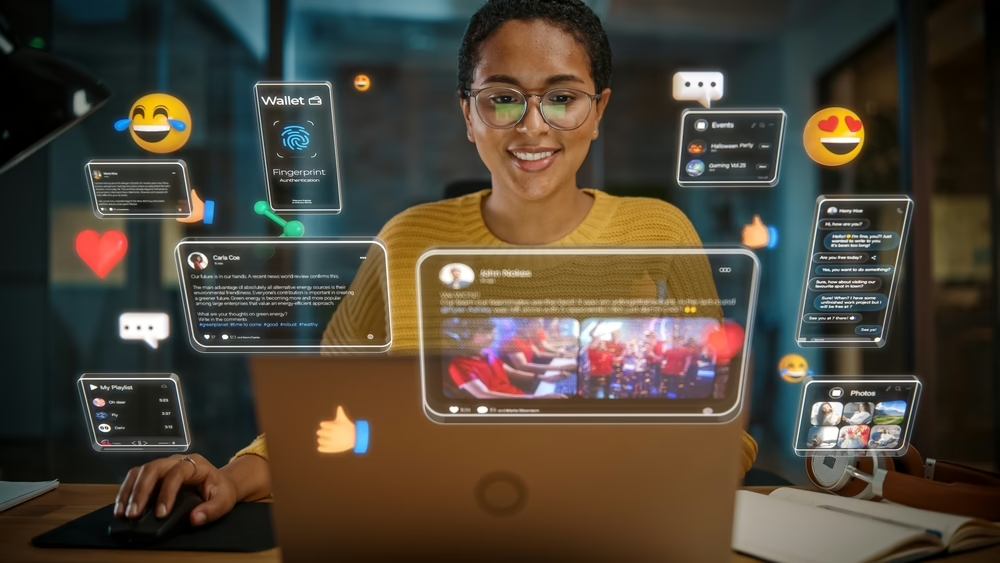
How Conversational Landing Pages Quickly Increase Conversion
As consumer options increase, speed becomes a sales language. How can businesses convert leads into buyers before they change their minds? A Chicago web development agency can help build a conversational landing page.
This blog post talks about a fascinating innovation in content marketing and explores these questions:
 A landing page is what users see when they click on a call-to-action (CTA) button such as “Buy now,” “Download this guide,” or “Fill out the form.” Compared to other website pages, this one has a clear, distinct purpose: to persuade the audience to take action. It is an effective, measurable tool for conversion. To make them work, marketers apply best practices. Digital Authority Partners (DAP) shares eight vital elements of a high-converting landing page. These are all good, except for one factor: they are often static. For this reason, even the most “well-designed” landing page feels uninviting, unengaging, and generic. It misses the chance to encourage users to stay longer, so you have more time to convert them. Most of all, it limits the consumers’ ability to exert power and control over their choices. After all, the only one who gets a chance to talk on a static landing page is the brand. Relationships grow only when all parties feel heard, which is what a conversational landing page offers.
A landing page is what users see when they click on a call-to-action (CTA) button such as “Buy now,” “Download this guide,” or “Fill out the form.” Compared to other website pages, this one has a clear, distinct purpose: to persuade the audience to take action. It is an effective, measurable tool for conversion. To make them work, marketers apply best practices. Digital Authority Partners (DAP) shares eight vital elements of a high-converting landing page. These are all good, except for one factor: they are often static. For this reason, even the most “well-designed” landing page feels uninviting, unengaging, and generic. It misses the chance to encourage users to stay longer, so you have more time to convert them. Most of all, it limits the consumers’ ability to exert power and control over their choices. After all, the only one who gets a chance to talk on a static landing page is the brand. Relationships grow only when all parties feel heard, which is what a conversational landing page offers.
Here is an example of how this feature works: A new Lakeview cafe hires a Chicago web development agency to build a chatbot. Its elements can include Conversational landing pages increase conversion rates quickly through the following:
Conversational landing pages increase conversion rates quickly through the following:
- What is a conversational landing page?
- How does it differ from other types of landing pages?
- What are its primary features?
- How does it increase conversion fast?
To learn how Digital Authority Partners can create a standout website for you, watch this video!
The Anatomy of a Conversational Landing Page
 A landing page is what users see when they click on a call-to-action (CTA) button such as “Buy now,” “Download this guide,” or “Fill out the form.” Compared to other website pages, this one has a clear, distinct purpose: to persuade the audience to take action. It is an effective, measurable tool for conversion. To make them work, marketers apply best practices. Digital Authority Partners (DAP) shares eight vital elements of a high-converting landing page. These are all good, except for one factor: they are often static. For this reason, even the most “well-designed” landing page feels uninviting, unengaging, and generic. It misses the chance to encourage users to stay longer, so you have more time to convert them. Most of all, it limits the consumers’ ability to exert power and control over their choices. After all, the only one who gets a chance to talk on a static landing page is the brand. Relationships grow only when all parties feel heard, which is what a conversational landing page offers.
A landing page is what users see when they click on a call-to-action (CTA) button such as “Buy now,” “Download this guide,” or “Fill out the form.” Compared to other website pages, this one has a clear, distinct purpose: to persuade the audience to take action. It is an effective, measurable tool for conversion. To make them work, marketers apply best practices. Digital Authority Partners (DAP) shares eight vital elements of a high-converting landing page. These are all good, except for one factor: they are often static. For this reason, even the most “well-designed” landing page feels uninviting, unengaging, and generic. It misses the chance to encourage users to stay longer, so you have more time to convert them. Most of all, it limits the consumers’ ability to exert power and control over their choices. After all, the only one who gets a chance to talk on a static landing page is the brand. Relationships grow only when all parties feel heard, which is what a conversational landing page offers.What Is a Conversational Landing Page?
Conversational landing pages integrate chatbots or virtual live agents. These artificial intelligence (AI) tools interact with the users in many ways. They can answer basic questions, introduce the brand, offer promos or discounts, or reroute concerns to the right departments. They can even assist patients. Chatbots have been around since the 1960s. Developers understood their implications even then. However, they only recently had the technology and foresight to see their practical uses. Today, these types of human-like automation are successful tools for lead generation. They help landing pages turn the user experience into an interactive dialogue to enhance personalization, engagement, and understanding of user intent.Common Features of a Conversational Landing Page
Conversational landing pages share the following attributes:| Features | How It Works |
|---|---|
| Interactive chat interface | The page contains an interactive chat window that usually greets visitors or poses an introductory question to start the conversation. |
| User-driven content | The landing pages modify the content on the basis of the user’s responses. |
| CTA | The virtual agent displays prompts to guide users toward a specific action throughout the conversation. |
| Responsive design | The screen and even the conversations adapt to the device. |
| Integration with other tools | The chatbot works with customer relationship management (CRM) systems, email marketing tools, analytics platforms, and calendars to automate subsequent actions based on the conversation. |
| Fallback options | Users can connect to a human representative or access a knowledge base if the chatbot does not understand the question or can provide no further assistance. |
| Personalization | The landing page uses cookies or links to an analytics platform to obtain data to customize user experience further. For example, returning visitors might receive follow-up questions based on past interactions. |
| Natural language processing and machine learning | It can better understand and respond to user inputs and learn from its mistakes to improve future outputs. |
- The business’s logo;
- A digital menu that opens when prompted, possibly with images of featured dishes or drinks;
- Answers to common questions such as opening hours, vegan or gluten-free options, and Wi-Fi availability;
- Information about the space, such as outdoor seating, ambiance, accessibility, and unique offerings (e.g., live music or art exhibits);
- Google Maps integration to show the shop’s location, nearby parking, and the nearest el station;
- An option for users to leave feedback or reviews;
- Advanced features, such as the ability to place an order or make a reservation; and
- Personalized recommendations based on user inputs.
How Conversational Landing Pages Increase Conversion Rates
 Conversational landing pages increase conversion rates quickly through the following:
Conversational landing pages increase conversion rates quickly through the following:- Enhanced user or customer perception
- Improved user segmentation
- Integrated human intervention
1. Enhanced User or Customer Perception
Studies say that it takes only 0.05 seconds for someone to judge a website. In such a fleeting moment, first impressions matter immensely. A conversational landing page immediately engages visitors, making them feel acknowledged and valued. This direct engagement builds confidence, transparency, and assurance. Most of all, it fosters trust. In a small Chinese study, the good interaction and accurate information from AI chatbots encouraged potential tourists to trust the business and purchase its products.2. Improved User Segmentation
Chatbot perceptions vary among demographics. One study suggested that newer generations might be more receptive to chatbots. Their older counterparts might prefer more social or friendlier bots. An expert Chicago web development company understands market nuances and applies them in personalizing the landing page.- Gen Z users might receive more concise, direct answers. The tone changes to conversational when the audience is Gen Xers.
- A chatbot for Japanese users might sound more formal.
- Small-business conversational landing pages sound more community-centric or localized.
- Tech-savvy users might require more detailed and data-driven information. Others might prioritize simplicity and clarity.
3. Integrated Human Intervention
Despite their benefits, virtual agents are fallible. They can respond inappropriately or not understand a question immediately. A single mistake is enough to ruin the user experience and damage a brand’s reputation. In fact, a chatbot error caused Google to lose $100 billion. The good news is chatbots are trainable. Depending on the data they are exposed to, they become better and more accurate over time. You can also retain human intervention in your process, with the following benefits:- Users often feel more secure knowing someone can assist them if a chatbot cannot answer.
- People excel at understanding nuanced problems or reading between the lines.
- Humans can offer empathy.
- Trained customer support agents can intervene when bots commit errors, reducing the potential for escalated issues or customer dissatisfaction.
Summing Up
Conversational landing pages increase user satisfaction and experience. When actively engaged, customers often reward the business with a purchase, loyalty, or both. Does your landing page need to be more interactive? Digital Authority Partners (DAP) is a Chicago web development company that creates dynamic, user-friendly digital solutions. Contact us today to schedule a consultation or a demo.Want To Meet Our Expert Team?
Book a meeting directly here



